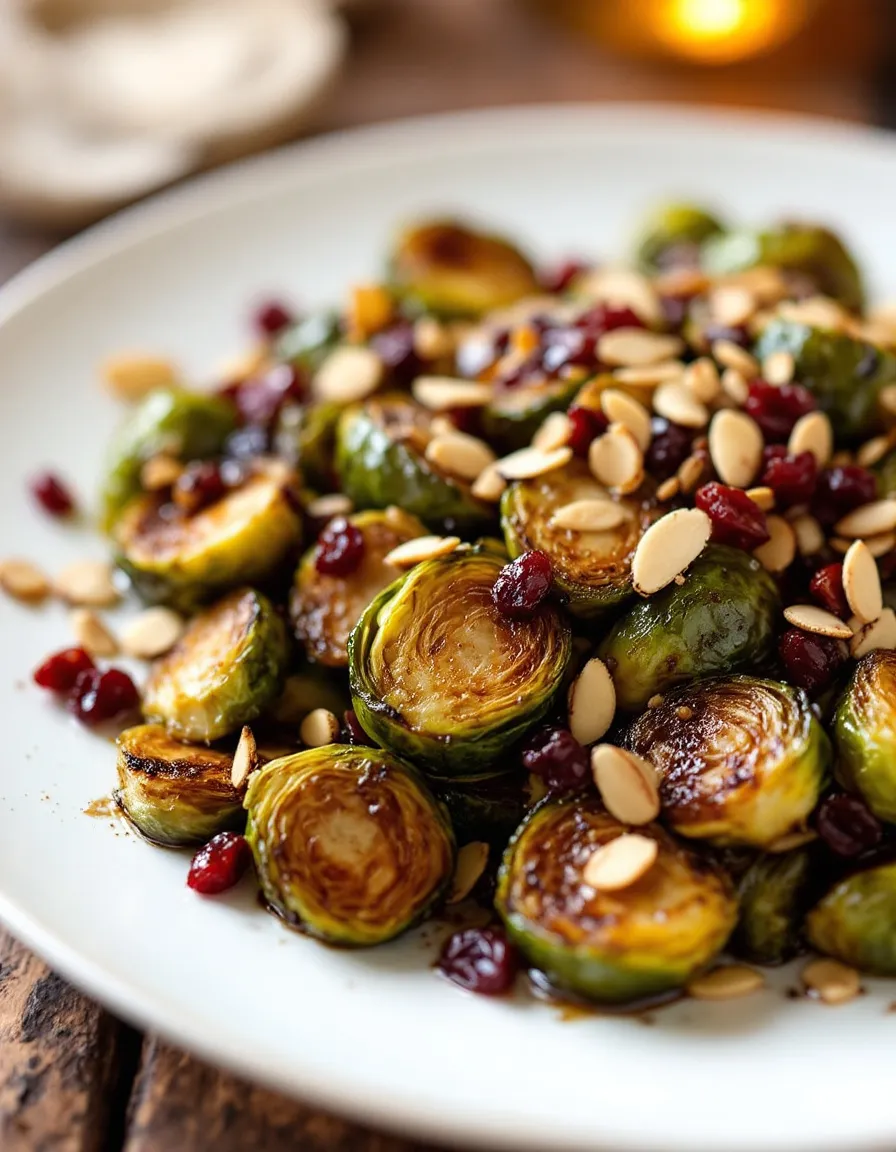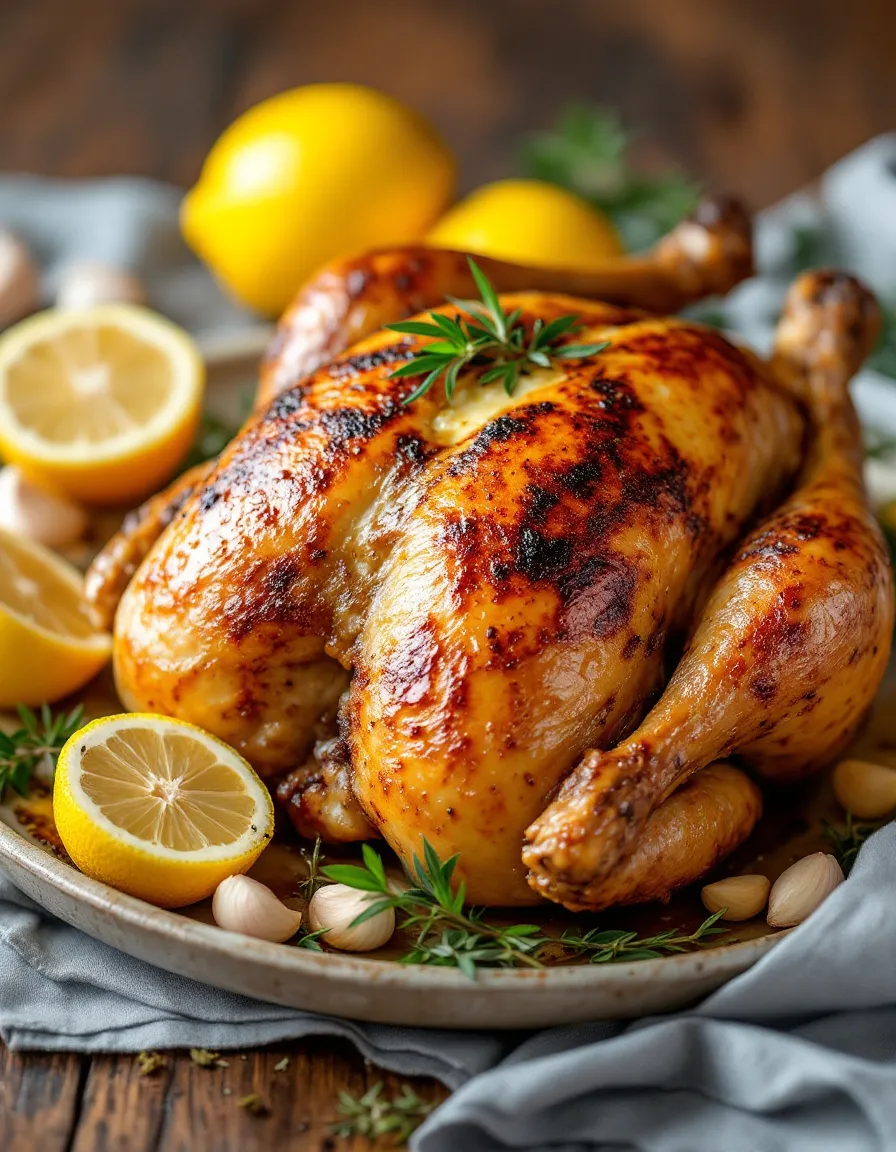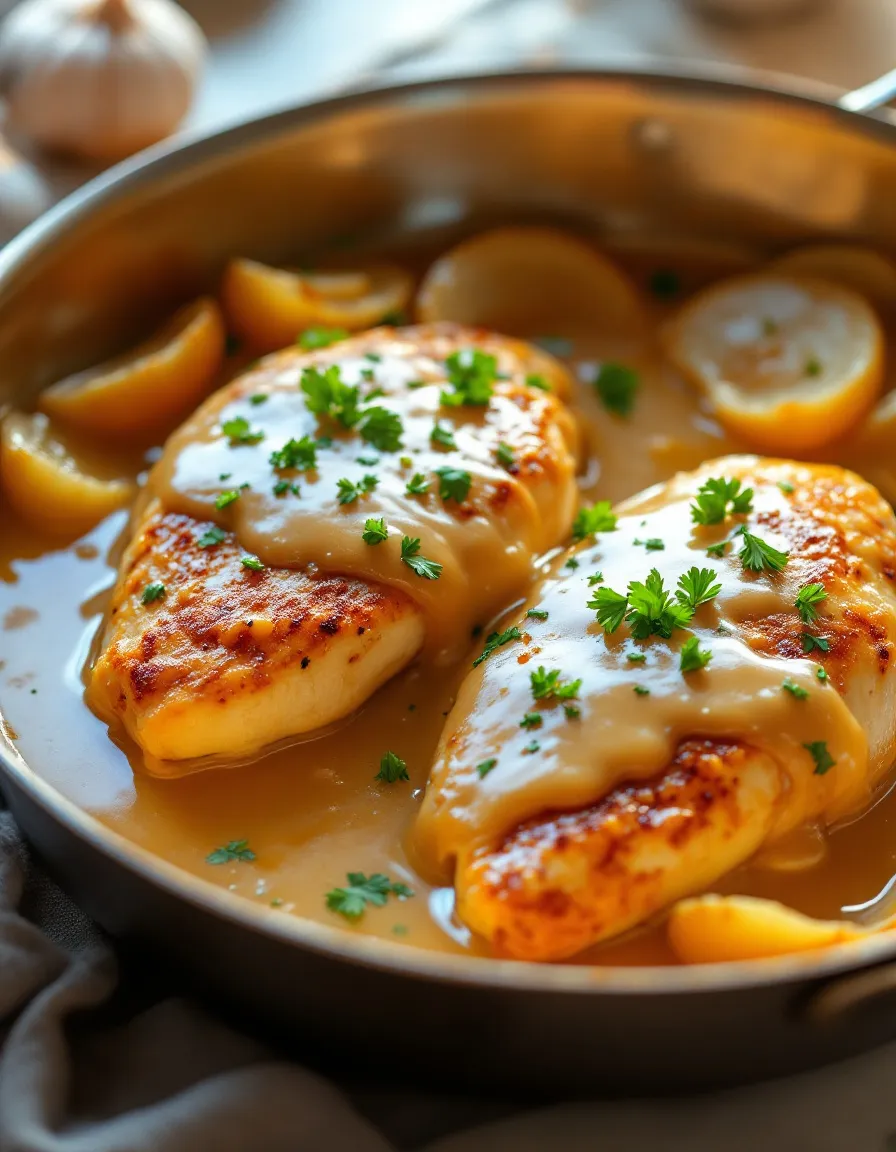Easy Maple Balsamic Brussels Sprouts: A Simple and Delicious Side Dish
Brussels sprouts often get a bad rap, but once you try these Easy Maple Balsamic Brussels Sprouts, you’ll want to make them a regular part of your meal rotation. The sweetness of maple syrup beautifully balances the tangy notes of balsamic vinegar, creating a dish that’s not only flavorful but also incredibly satisfying. Roasting these tiny cabbages brings out their natural sweetness and adds a crispy texture that is hard to resist.
This recipe makes it easy to prepare Brussels sprouts that shine on any dinner table or holiday spread. Whether you’re serving them alongside roasted meats, as a vegetarian main, or tossing them into salads, the flavor combination is versatile enough to elevate any meal. Plus, they’re a great way to introduce more vegetables into your diet without sacrificing taste.
Quick Recipe Highlights
- Flavor Profile: A delightful blend of sweetness and tang from the maple syrup and balsamic vinegar that enhances the natural flavors of Brussels sprouts.
- Texture: Tender on the inside with a satisfying crispy exterior, perfect for any palate.
- Aroma: The warm aroma of roasted vegetables mixed with the sweet smell of maple syrup and tangy balsamic will fill your kitchen with an inviting scent.
- Visual Appeal: The vibrant green of the Brussels sprouts, caramelized edges, and glossy finish from the glaze create an eye-catching dish.
- Skill Level Needed: Suitable for beginners, this recipe requires minimal cooking techniques such as chopping, tossing, and roasting.
- Special Equipment: A baking sheet and a mixing bowl are all you need to create this delectable dish.
Recipe Overview
- Difficulty Level: This Easy Maple Balsamic Brussels Sprouts recipe is straightforward, making it perfect for both novice cooks and seasoned chefs.
- Category: It’s a versatile side dish that easily fits into any meal, making it the perfect addition to weeknight dinners or festive occasions.
- Cuisine: While Brussels sprouts are often associated with European cuisine, the use of maple syrup and balsamic vinegar gives this dish a unique, modern twist.
- Cost: The ingredients are affordable and widely available, making this dish easy on the wallet for everyday meals.
- Season: Brussels sprouts are in peak season during the fall and winter months, making this the ideal recipe for cooler weather.
- Occasion: Great for holidays, potlucks, and family dinners, this dish is sure to impress guests and make any table festive.
Why You’ll Love This Recipe
This Easy Maple Balsamic Brussels Sprouts dish is packed with taste and texture. The balance of sweetness and acidity offers a delightful experience with each bite. The method of roasting enhances the natural flavors of the Brussels sprouts while ensuring that they maintain their crisp-tender perfection. Moreover, this dish can be effortlessly adapted to various flavors, allowing you to get creative in the kitchen.
Convenience is another reason to love this recipe. With just a few simple ingredients and minimal prep work, you can whip up a delicious side dish in no time. It’s a fantastic option for busy weeknights when you want something nutritious but don’t have hours to spend in the kitchen. The straightforward steps make it a great addition to your repertoire of easy weeknight meals.
In terms of nutritional advantages, Brussels sprouts are a powerhouse of vitamins K and C, fiber, and antioxidants. They contribute to a healthy diet, and when combined with the natural sweetness of maple syrup, they offer a guilt-free indulgence that you can feel good about serving to your family and friends.
This recipe is also perfect for entertaining. The stunning presentation and delicious flavor make it an ideal side for any meal, ensuring that your guests will be raving about it long after the meal is over. The easy preparation allows you to spend more quality time with loved ones while still serving something remarkable.
Lastly, the cost-effectiveness of this dish is significant. With just a few budget-friendly ingredients, you can create a gourmet-looking dish that impresses without overspending. It’s an excellent way to enjoy seasonal produce while sticking to your budget.
Historical Background and Cultural Significance
Brussels sprouts have a long history, believed to have originated in Belgium in the 16th century. They gained popularity in Europe and eventually made their way to the United States, where they have become a staple in many homes, especially during the fall and winter months. The appeal of Brussels sprouts has seen a resurgence in recent years as chefs and home cooks alike seek to highlight their unique flavor and adaptability.
Culturally, Brussels sprouts have significance in many cuisines, often associated with hearty meals and holiday feasts. They’ve transitioned from an often-overlooked vegetable to a trendy ingredient almost everywhere, being featured on menus across casual and fine dining restaurants. Their evolution in culinary circles reflects a growing appreciation for vegetables and plant-based dishes.
The evolution of recipes for Brussels sprouts has led to numerous adaptations and variations. From being boiled and bland, they are now often roasted or sautéed with rich flavors, such as garlic, bacon, or, in this case, maple syrup and balsamic vinegar. This versatility keeps them fresh and exciting, promoting their renewed popularity among health-conscious diners.
Moreover, regional variations of Brussels sprouts preserve their cultural importance. Different areas have their unique methods of preparation, such as adding local herbs or spices, which give them added character. This illustrates how a single ingredient can be celebrated in diverse culinary traditions.
Ingredient Deep Dive
Brussels sprouts are the star of this dish, known for their unique flavor and nutritional benefits. Characterized by their small, cabbage-like spheres, they belong to the Brassica family—which includes broccoli and kale—making them a nutrient-rich choice. Brussels sprouts are high in vitamins C and K, fiber, and antioxidants, contributing to overall well-being.
When selecting Brussels sprouts, look for firm, green heads with tightly packed leaves. Avoid any that are yellowing or wilted, as they may not taste as fresh. Store them in the refrigerator in a plastic bag to keep them crisp for longer. If you need a substitute, you can use green beans or even broccoli, keeping in mind that the cooking times may differ.
Maple syrup—an essential component of this dish—not only adds sweetness but also brings a unique flavor that enhances the Brussels sprouts. Traditionally produced in North America, maple syrup is rich in antioxidants and offers some minerals, making it a healthier sweetener alternative compared to refined sugars. When selecting maple syrup, choose pure maple syrup over imitation varieties for the best flavor and quality.
Balsamic vinegar, another key ingredient, lends a tangy flavor that beautifully complements the sweetness of maple. This vinegar is made from the fermentation of grape must, and its complexity evolves over time. Balsamic vinegar is relatively low in calories but adds depth and an appealing tartness to dishes. Look for high-quality balsamic that has a rich, syrupy consistency for the best results. If you need a substitute, consider using apple cider vinegar or red wine vinegar, though the flavor profile will differ slightly.
Common Mistakes to Avoid
- Not trimming the Brussels sprouts: Always remove the woody ends and any yellow outer leaves to ensure even cooking and a more pleasant taste.
- Overcrowding the baking sheet: Give the Brussels sprouts space to roast properly. Too many in a pan can lead to steaming instead of roasting, resulting in a soggy texture.
- Neglecting to season adequately: Salt and pepper may seem basic, but they are essential for enhancing the flavors. Don’t skip these or rely solely on the syrup.
- Using cheap balsamic vinegar: Opt for a high-quality balsamic; it makes a significant difference in flavor and the overall dish.
- Roasting at too low a temperature: Aim for a high oven temperature to achieve that crispy, caramelized exterior on the Brussels sprouts.
- Overcooking: Keep an eye on the sprouts as they cook to prevent them from becoming mushy; they should be tender yet crisp.
- Ignoring stirring: Stirring helps promote even cooking and ensures that every sprout gets that delicious caramelization.
- Skipping the preheating phase: Always preheat the oven properly before roasting to ensure optimal cooking temperatures from the start.
- Cooking in a too-large pan: If your baking sheet is too big, the heat can dissipate too much, leading to uneven cooking.
- Choosing the wrong type of maple syrup: Pure maple syrup will yield a better flavor than imitation syrup, so always check the label.
Essential Techniques
Roasting is a critical technique for this Easy Maple Balsamic Brussels Sprouts dish. It enhances the flavor and texture of the Brussels sprouts, creating a caramelized exterior while keeping the inside tender. To master roasting, make sure your oven is properly preheated and that you toss the sprouts to ensure even cooking. Look for a golden-brown color as a cue that they’re perfectly roasted.
Another important technique is effectively combining flavors. When mixing the balsamic and maple syrup with the Brussels sprouts, ensure every sprout is coated evenly. This will contribute to a balanced taste and prevent any individual sprout from being overwhelmed by the sweetness or acidity. Don’t hesitate to adjust the ratios based on your palate, and remember that the glaze can be tweaked for a sweeter or more tangy profile.
Pro Tips for Perfect Easy Maple Balsamic Brussels Sprouts
1. For added depth of flavor, consider adding minced garlic or shallots to the Brussels sprouts before roasting. This will infuse them with a rich aroma and taste.
2. Experiment with different sweeteners like honey or agave syrup for a unique flavor twist. Adjust the quantity based on personal preference.
3. Add a sprinkle of crushed red pepper flakes for a touch of heat, balancing the sweetness and tanginess beautifully.
4. Top the finished dish with toasted nuts for a crunch and an additional layer of flavor; walnuts or pecans work wonderfully in this recipe.
5. If you have some fresh herbs on hand, consider sprinkling some chopped thyme or rosemary over the sprouts before serving for a fresh touch.
6. For a smoky twist, toss in diced bacon or pancetta before roasting. This adds a savory layer that complements the sweet and tangy flavors beautifully.
7. Keep an eye on the baking time; smaller sprouts will cook faster than larger ones, so they may benefit from being cut in half or quartered.
8. Allow the dish to cool slightly before serving, as this will help the flavors settle and offers a more pleasant eating temperature.
Variations and Adaptations
Brussels sprouts are incredibly adaptable, allowing for numerous flavor accents. Consider creating seasonal variations by incorporating fall elements such as roasted butternut squash or cranberries. This twist adds unexpected sweetness and visual color, elevating the dish’s appeal.
For those with dietary restrictions, the Easy Maple Balsamic Brussels Sprouts recipe can be modified to be vegan by ensuring all ingredients are plant-based. You might also explore gluten-free options by pairing them with naturally gluten-free grains or dishes.
You can also change the texture by experimenting with cooking techniques. For example, you might try sautéing instead of roasting for a softer sprout, or you could opt for grilling them for a smoky flavor. Additionally, if you enjoy a sweeter dish, adding more maple syrup can completely change the flavor profile.
Finally, presentation plays a key role. Instead of serving them as is, consider stacking them atop creamy polenta or quinoa for a captivating dish that’s as visually stunning as it is delicious.
Serving and Presentation Guide
When plating your Easy Maple Balsamic Brussels Sprouts, aim for a clean and tidy presentation. Use a wide-brimmed bowl or a platter, allowing the vibrant green color to stand out. Consider garnishing with freshly chopped parsley or microgreens for a pop of color and freshness.
Pair your Brussels sprouts with a selection of complementary dishes to enhance the dining experience, such as garlic mashed potatoes, grilled chicken, or holiday ham. For modern serving suggestions, consider serving them in individual ramekins to give a fancy touch to casual dining.
Temperature is key; serve the Brussels sprouts warm to maintain their crispness and full flavor. For portion control, a serving size of about half a cup is usually fitting as a side dish.
Wine and Beverage Pairing
When it comes to wine pairings for Easy Maple Balsamic Brussels Sprouts, a Pinot Noir is an excellent match. The bright acidity and low tannins complement the sweetness of the maple syrup and the acidity of the balsamic vinegar. If you prefer white wine, opt for a Chardonnay with a bit of oak to add complexity.
For non-alcoholic options, light herbal teas or sparkling water with a twist of lemon can provide a refreshing accompaniment. If you’d rather have coffee or tea, a strong black coffee brewed without heavy flavors will complement the maple’s sweetness without overwhelming the palate.
Always consider the temperature of the beverage; serve white wines chilled and red wines slightly below room temperature for the best tasting experience.
Storage and Shelf Life
For optimal freshness, store any leftover Easy Maple Balsamic Brussels Sprouts in an airtight container in the refrigerator. They are best consumed within 3 days; however, expect some texture changes as they sit stored.
To reheat, microwave them in short bursts, stirring in between, or place them in a preheated oven at 350°F (175°C) until warmed through. Avoid reheating multiple times as this diminishes the quality.
If you want to extend the shelf life, consider freezing the cooked Brussels sprouts. Lay them flat on a baking tray to freeze individually before transferring them to a freezer-safe bag. Consume them within 2 months for the best flavor and texture.
Make Ahead Strategies
To save time, you can prep the Brussels sprouts a day in advance. Wash and trim them, then store them in an airtight container in the refrigerator, ready to roast when you’re prepared to cook.
Alternatively, you can roast them ahead of time and reheat as needed. They can also be added to any cooked grain or salad to create a more substantial meal. To keep them fresh, add dressings or sauces just before serving for the best flavor and texture.
When planning a meal, consider roasting the Brussels sprouts alongside proteins to maximize your kitchen time. This way, everything finishes cooking simultaneously, making for a more efficient cooking process.
Scaling Instructions
This Easy Maple Balsamic Brussels Sprouts recipe can easily be scaled up or down depending on your needs. To halve the recipe, simply reduce the ingredient amounts by 50% while keeping the same cooking time, as slight changes in quantity will not significantly alter results.
If you’re looking to serve a larger crowd, feel free to double or triple the ingredients. Just be mindful of the spacing on your baking sheet. You may need to use multiple sheets to avoid overcrowding and ensure proper roasting.
Remember that larger quantities may require an additional few minutes of cooking time; just check for doneness based on your desired texture and color.
Nutritional Deep Dive
When considering the nutrition of Easy Maple Balsamic Brussels Sprouts, per serving, you’ll find a healthy balance of macronutrients. The dish offers a source of carbohydrates from the maple syrup but remains low in simple sugars compared to many sweetened dishes, making it a smarter choice for sweetness.
Brussels sprouts are also an excellent source of vitamins K and C, which are vital for bone health and immune function, respectively. A serving contains fiber that aids digestion, promoting overall gut health.
When moderate in calories, each serving of this dish provides essential nutrients while allowing you to maintain a balanced diet. This recipe can easily fit into various dietary plans, enhancing its appeal to health-conscious diners.
In terms of portion analysis, moderation is key. Enjoying a half-cup serving alongside other healthy dishes promotes a satisfying and well-rounded meal without excessive caloric intake.
Dietary Adaptations
This Easy Maple Balsamic Brussels Sprouts recipe can be easily adapted to suit a variety of dietary needs. For gluten-free individuals, the recipe is naturally gluten-free, allowing for a delicious side dish that everyone can enjoy.
Vegans will also find this recipe appealing as it does not include any animal products. The fresh, natural ingredients are perfect for any plant-based diet.
For those following low-carb or keto diets, consider reducing the amount of maple syrup to minimize carbs, or substituting it with a keto-friendly sweetener like erythritol for a low-sugar alternative.
Lastly, if you’re adapting the dish for a low-FODMAP diet, ensure to use a smaller quantity of balsamic vinegar, as it can cause digestive issues for some.
Troubleshooting Guide
If you find that your Brussels sprouts have a chewy texture, it’s likely that they were not cooked long enough, or perhaps they were overcrowded on the baking sheet. Ensure that they have enough space to roast properly, allowing hot air to circulate.
For flavor balance issues, pay attention to the proportions of maple syrup and balsamic vinegar. If your dish turns out too sweet, consider adding a splash of balsamic vinegar to counterbalance the flavors.
If you’re having trouble with uneven roasting, make sure to stir the Brussels sprouts halfway through cooking. This allows them to brown evenly and avoid burning on one side.
Utilizing the wrong equipment can also lead to baking troubles. Non-stick pans often don’t provide the optimal surface for roasting; instead, try using a heavy-duty baking sheet for the best results.
Keep an eye on timing as well. If you’re unfamiliar with your oven’s true temperature, invest in an oven thermometer to ensure accuracy, which can dramatically affect the outcome of your dish.
Recipe Success Stories
Many have shared delightful experiences when preparing Easy Maple Balsamic Brussels Sprouts. Community feedback highlights the ease of the recipe and its surprisingly satisfying taste, turning sprout skeptics into enthusiasts.
Several readers have reported variations that worked well, such as adding crumbled feta or incorporating roasted nuts, proving the versatility of this dish. They often rave about how guests who previously turned their noses up at Brussels sprouts have gone back for seconds.
Cooks have also noted that the visual appeal of these Brussels sprouts, with their caramelized edges and glossy finish, has made them a show-stopper on holiday tables and at family gatherings.
Photography tips from home cooks have also emerged, suggesting that taking shots during different stages of preparation can yield stunning visuals to share on social media. The colorful presentation has inspired many to try their hand at recreating this dish with their own unique flair.
Frequently Asked Questions
Can I use frozen Brussels sprouts?
While fresh Brussels sprouts yield the best texture and flavor, frozen Brussels sprouts can be used in a pinch. Just ensure they’re thawed and drained well before roasting to minimize excess moisture.
How do I know when Brussels sprouts are done?
Your Brussels sprouts are done when they are tender on the inside and slightly browned on the outside. A fork should easily pierce through, and they should have a nice caramelization.
Can I prepare this dish in advance?
Yes, you can prep the Brussels sprouts a day ahead of time, keeping them stored in the refrigerator. However, it’s best to roast them fresh to maintain their crispy texture.
What can I serve with these Brussels sprouts?
These Brussels sprouts pair well with roasted meats, such as chicken or pork, and can also complement grains like quinoa or couscous. They make a great addition to salads too.
Is this dish healthy?
Absolutely! Brussels sprouts are packed with nutrients, and the maple syrup adds a touch of sweetness without excessive calories. It’s a nutritious side dish that can complement any meal.
Can I use another sweetener instead of maple syrup?
Yes, you can experiment with honey or agave syrup, but this may alter the flavor slightly. Ensure any substitutions maintain a similar sweetness profile.
How do I store leftovers?
Store any leftover Brussels sprouts in an airtight container in the refrigerator for up to 3 days. To reheat, either microwave them for a few minutes or warm them in the oven.
What if my Brussels sprouts don’t crisp up?
If your Brussels sprouts are not crispy, it could be due to overcrowding on the baking sheet or baking at too low a temperature. Spread them out and ensure your oven is hot enough before roasting.
Can I freeze the leftovers?
Yes, you can freeze cooked Brussels sprouts. Lay them flat on a baking tray to freeze individually before transferring them to a freezer-safe bag, and consume them within 2 months.
Are there any variations I can make to the recipe?
Definitely! You can add nuts for crunch, incorporate different vegetables, or change the seasoning to suit your taste. The base recipe can be adjusted easily for quinoa salads or grain bowls.
Additional Resources
Explore more delicious side dishes like Roasted Garlic Mashed Potatoes or Honey-Glazed Carrots to complement your meals. For technique guides, consider checking out roasting tips or exploring how to select the best fresh vegetables.
Ingredient information on Brussels sprouts and seasonal variations can also enhance your meal planning, allowing you to make the most of what’s available. Consider investing in high-quality kitchen equipment that makes prepping and cooking easier.
Join the Conversation
We encourage you to share your experiences with Easy Maple Balsamic Brussels Sprouts on social media! Post your photos and tag us; we love seeing how everyone makes this dish their own. Your feedback can inspire others to give Brussels sprouts another chance, and we welcome your variations and adaptations as well.
For more discussions about healthy eating, cooking tips, and recipe variations, join our community. Let’s share, learn, and enjoy great food together!
The Recipe
Easy Maple Balsamic Brussels Sprouts
Serves: 4
Prep Time: 10 mins
Cook Time: 20 mins
Total Time: 30 mins
Kitchen Equipment Needed
- Baking sheet
- Mixing bowl
- Sharp knife
- Cutting board
Ingredients
- 1 pound Brussels sprouts, trimmed and halved
- 2 tablespoons maple syrup
- 2 tablespoons balsamic vinegar
- 2 tablespoons olive oil
- Salt and pepper, to taste
Directions
- Preheat your oven to 400°F (200°C).
- In a mixing bowl, combine the halved Brussels sprouts, olive oil, maple syrup, balsamic vinegar, salt, and pepper.
- Toss everything until the Brussels sprouts are evenly coated.
- Spread the Brussels sprouts onto a baking sheet in a single layer.
- Roast in the preheated oven for about 20 minutes, or until tender and caramelized, stirring halfway through.
- Remove from oven and adjust seasoning if necessary before serving.
Recipe Notes
- For added crunch, top with toasted nuts before serving.
- This dish can be prepared a day ahead; simply reheat before serving.
- Feel free to adjust the sweetness of the glaze to your liking!










